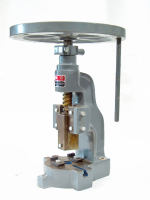Overland
Stainless
- Joined
- Nov 19, 2017
- Location
- Greenville, SC
I was thinking about a flypress recently, and it took me back to my time as a kid working Saturday mornings at a little shop, and using a flypress to make brackets and the like.
This type of presses uses a multi-start "square" thread to create the force.
I can see how the thread on the "bolt" could be made on a lathe, but the "nut" seems to be machined directly into the casting, I think.
These are pretty massive screw threads being perhaps 3" diameter with thread grooves certainly 1/4" deep.
I can't get my head round a tap that size; nor how you would "single point" it in a vertical mill.
These presses were mass produced back in the 18 th century, so nothing too sophisticated.
Maybe it was a bushing.
I'd be interested if anyone knows.
Bob
In the image below, the "nut" is in the frame above the scewthread showing, and the block below the thread holds the tool.

This type of presses uses a multi-start "square" thread to create the force.
I can see how the thread on the "bolt" could be made on a lathe, but the "nut" seems to be machined directly into the casting, I think.
These are pretty massive screw threads being perhaps 3" diameter with thread grooves certainly 1/4" deep.
I can't get my head round a tap that size; nor how you would "single point" it in a vertical mill.
These presses were mass produced back in the 18 th century, so nothing too sophisticated.
Maybe it was a bushing.
I'd be interested if anyone knows.
Bob
In the image below, the "nut" is in the frame above the scewthread showing, and the block below the thread holds the tool.




